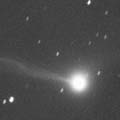
|
Now it appears in the morning sky. It is 6.9 mag, brighter than expected (Sept. 22, Reinder J. Bouma). Very strongly condensed and easy to see. It will keep 6.5-7 mag until the end of October. In the Northern Hemisphere, it locates low in the morning sky in September. But it will turn to locate in the evening sky after early October, then it keeps observable in the evening sky until early January while fading gradually. In the Southern Hemisphere, it cannot be observable until next April when it becomes fainter than 15 mag.
Date(TT) R.A. (2000) Decl. Delta r Elong. m1 Best Time(A, h)
Sept.23 11 26.51 28 6.3 1.500 0.791 29 6.9 4:23 (239, 5)
Sept.30 12 0.83 32 11.9 1.347 0.784 35 6.6 4:29 (236, 8)
|
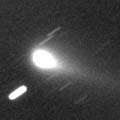
|
Now it is 10.7 mag (Sept. 22, Jakub Cerny). It is somewhat fainter than this ephemeris, however, it is well condensed and easy to see. It will be brightening rapidly after this, and will reach to 9 mag from autumn to winter, and observable in its best condition. It keeps 14 mag still in 2007 March, so it keeps visible visually for a long time.
Date(TT) R.A. (2000) Decl. Delta r Elong. m1 Best Time(A, h)
Sept.23 2 1.47 14 0.4 0.823 1.750 146 10.1 1:56 ( 0, 69)
Sept.30 2 5.01 13 1.7 0.777 1.731 153 9.8 1:32 ( 0, 68)
|
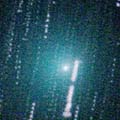
|
Recovered after 117 year blank since 1889. It brightened rapidly in mid July and reached to 8 mag. Then it kept bright at 8 mag with a large diffuse coma until early September. But it has already started fading. Now it is 9.7 mag (Sept. 20, Jakub Cerny). It will fade out rapidly after this. Because it is very diffuse, it can be invisible soon. In the Northern Hemisphere, it keeps locating very high in the evening sky for a long time after this. It moves around the Northern Pole, so it will be observable all night until November, although it becomes low in the morning.
Date(TT) R.A. (2000) Decl. Delta r Elong. m1 Best Time(A, h)
Sept.23 18 3.81 68 46.7 0.611 1.178 90 9.9 19:20 (167, 54)
Sept.30 18 41.40 71 14.4 0.632 1.220 93 10.4 19:10 (172, 53)
|

|
It is bright as 12.6 mag and visible visually (June 21, Juan Jose Gonzalez). In the Northern Hemisphere, it locates rather low in the evening. It will be too low at dusk to observe in October. But it will be getting higher in the morning sky after December. It keeps 13 mag until 2007 March, so it will be visible visually for a long time.
Date(TT) R.A. (2000) Decl. Delta r Elong. m1 Best Time(A, h)
Sept.23 14 39.14 0 17.6 2.783 2.115 40 13.0 19:20 ( 80, 15)
Sept.30 14 45.92 1 37.7 2.819 2.089 35 12.9 19:10 ( 83, 13)
|

|
A small outburst occured in late August, and it was visible visually, bright and strongly condensed, in early September. It is visible at 13.9 mag still now (Sept. 22, Jakub Cerny). Since it appeared in the morning sky in early July, it has been bright as 12-13 mag and visible visually. It is observable in good condition until winter.
Date(TT) R.A. (2000) Decl. Delta r Elong. m1 Best Time(A, h)
Sept.23 4 25.06 31 26.1 5.424 5.841 109 13.4 4:19 ( 0, 86)
Sept.30 4 24.92 31 35.3 5.326 5.843 116 13.4 3:51 ( 0, 87)
|

|
It reached up to 10.3 mag on July 7 (Juan Jose Gonzalez). Then it is fading gradually. Now it is 12.6 mag (Sept. 11, Walter Ruben Robledo). It had been very low, only about 15 degree high in the Northern Hemisphere. But it will get higher gradually after this. However, it will be too faint to see visually soon.
Date(TT) R.A. (2000) Decl. Delta r Elong. m1 Best Time(A, h)
Sept.23 20 20.06 -35 13.8 1.167 1.864 118 13.5 20:12 ( 0, 20)
Sept.30 20 30.05 -33 51.6 1.256 1.899 114 13.8 19:54 ( 0, 21)
|

|
It has been lost since its discovery in 1986. The condition is good in this return. In calculation, it will be 14 mag from autumn to winter. However, it was probably in outburst and brightened unexpectedly at the discovery. Actually, it must be much fainter than expected in this apparition. Although it has been listed up as an observable target since May, it has not been recovered yet. In the Northern Hemisphere, it keeps observable until it fades out in next spring. When it becomes brightest in October and November, it will move away from the Milky Way. So it will be easier to recover.
Date(TT) R.A. (2000) Decl. Delta r Elong. m1 Best Time(A, h)
Sept.23 18 10.04 -22 16.4 1.150 1.560 92 14.2 19:20 ( 21, 30)
Sept.30 18 24.64 -22 5.4 1.170 1.528 89 14.1 19:10 ( 22, 30)
|

|
It had been observed at 10 mag in the evening sky from winter to spring. Although it has been unobservable since May, now it is appearing in the morning sky again. Now it is 14.5 mag (Sept. 2, Ken-ichi Kadota). It will come to locate high in October, then it will be visible visually again at 14 mag.
Date(TT) R.A. (2000) Decl. Delta r Elong. m1 Best Time(A, h)
Sept.23 9 19.39 26 47.1 3.701 3.100 46 14.2 4:23 (256, 29)
Sept.30 9 27.68 26 13.4 3.695 3.169 51 14.2 4:29 (259, 33)
|

|
It will pass only 0.17 A.U. from the sun in 2007 January. Althohgh it was reported as 17 mag at the discovery, it is actually much brighter. It was 13.5 mag on Sept. 13, with a very large diffuse coma of 2.5 arcmin (Michael Jager). It is already so bright as about 12.5 mag visually (Sept. 22, Piotr Guzik). The comet will be brightening gradually after this, but it keeps locating low in the evening in the Northern Hemisphere. It will be observable only until early November when it becomes 12.5 mag. It is expected to reach up to 4.5 mag in January, but it is not observable at that time. After the perihelion passage, it is only observable in the Southern Hemisphere. In the Southern Hemisphere, it will appear at 8 mag in late January, then it keeps observable while fading gradually.
Date(TT) R.A. (2000) Decl. Delta r Elong. m1 Best Time(A, h)
Sept.23 16 21.48 -15 11.5 2.611 2.395 66 14.4 19:20 ( 50, 23)
Sept.30 16 23.47 -14 55.7 2.615 2.288 60 14.2 19:10 ( 53, 21)
|

|
Now it is 14.3 mag and almost asteroidal (Sept. 20, Edwin van Dijk). Although the slight cometary activity was detected in late July, its faint tail became too hard to detect now. In the Northern Hemisphere, it keeps good condition after this. It keeps locating high until next spring. If it keeps asteroidal after this, it will be 13.7 mag at best. However, it may suddenly become active and brighten rapidly someday.
Date(TT) R.A. (2000) Decl. Delta r Elong. m1 Best Time(A, h)
Sept.23 21 18.64 28 5.2 1.008 1.840 132 14.4 21:09 ( 0, 83)
Sept.30 21 6.07 29 0.7 0.991 1.776 126 14.3 20:29 ( 0, 84)
|

|
It has been visible at 13.5 mag for a long time since last autumn until spring. Now it is not observable. However, it will be observable in good condition again at 14.5 mag in winter.
Date(TT) R.A. (2000) Decl. Delta r Elong. m1 Best Time(A, h)
Sept.23 11 51.44 27 57.3 6.205 5.339 27 14.4 4:23 (236, 1)
Sept.30 11 58.32 27 11.4 6.190 5.351 30 14.4 4:29 (240, 5)
|
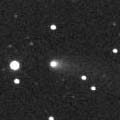
|
It is bright as 13.7 mag and visible visually (Aug. 22, Seiichi Yoshida). It keeps locating at the same altitude until December. But it will be too faint to see visually in October.
Date(TT) R.A. (2000) Decl. Delta r Elong. m1 Best Time(A, h)
Sept.23 22 11.82 -23 44.1 2.448 3.319 144 14.9 22:03 ( 0, 31)
Sept.30 22 9.17 -23 37.0 2.520 3.332 137 15.0 21:32 ( 0, 31)
|

|
It was missed in 1999 due to the bad condition. The condition is good in this return. It will reach to 13.5 mag in November. Although it is too low in the Northern Hemisphere now, it locates high in the Southern Hemisphere. It must be already bright as 15 mag, but it has not been recovered yet. In the Northern Hemisphere, it will be getting higher gradually after mid October.
Date(TT) R.A. (2000) Decl. Delta r Elong. m1 Best Time(A, h)
Sept.23 17 51.50 -48 12.7 0.916 1.345 88 15.2 19:20 ( 16, 4)
Sept.30 18 11.04 -47 5.0 0.902 1.298 85 15.0 19:10 ( 16, 5)
|
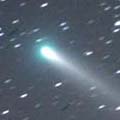
|
It reached to 6 mag at best in early May at the remarkable approach to the earth, when it became double naked eye comets with the component B around the zenith. Now it is going away from the earth and fading. It has already faded down to 13.0 mag (Aug. 22, Seiichi Yoshida). It will be too faint to see visually soon. The component B has faded out rapidly since June, and already so faint, fainter than 17 mag.
Date(TT) R.A. (2000) Decl. Delta r Elong. m1 Best Time(A, h)
Sept.23 1 25.17 -16 57.8 0.757 1.713 152 15.1 1:20 ( 0, 38)
Sept.30 1 12.13 -16 49.5 0.812 1.778 157 15.5 0:40 ( 0, 38)
|

|
It is observable in good condition at 15 mag in September and October.
Date(TT) R.A. (2000) Decl. Delta r Elong. m1 Best Time(A, h)
Sept.23 6 18.56 73 45.7 0.510 1.114 88 15.3 4:23 (192, 49)
Sept.30 3 30.65 76 21.9 0.515 1.217 101 15.3 3:04 (180, 49)
|

|
It was in major outburst unexpectedly and reached to 10.5 mag in its last appearance in 1999. It was already recovered in 2005 October. But it has not been observed for 1 year since that. So the current brightness is quite uncertain. It has already appeared in the morning sky. It is expected to be 15.5 mag, but actually, it can be much fainter than this ephemeris. It will fade out gradually after this.
Date(TT) R.A. (2000) Decl. Delta r Elong. m1 Best Time(A, h)
Sept.23 10 19.51 13 3.5 2.621 1.796 27 15.5 4:23 (261, 10)
Sept.30 10 35.99 11 4.4 2.605 1.811 30 15.5 4:29 (265, 12)
|
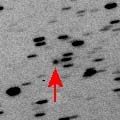
|
Now it is 16.5 mag (Sept. 2, Ken-ichi Kadota). It keeps 16 mag until December. It keeps observable until February when it becomes fainter than 18 mag.
Date(TT) R.A. (2000) Decl. Delta r Elong. m1 Best Time(A, h)
Sept.23 8 18.86 19 53.8 1.877 1.581 57 15.7 4:23 (271, 38)
Sept.30 8 37.07 17 38.5 1.840 1.587 59 15.7 4:29 (276, 40)
|

|
It is outside of Jupiter's orbit, so it keeps observable for a long time. Now it is 15.8 mag (June 2, Ernesto Guido and Giovanni Sostero). In 2006, it is still faint and locating somewhat low. But in 2007 and 2008, it is expected to be bright as 14.5-15 mag. It will locate high at that time, so it may be visible visually.
Date(TT) R.A. (2000) Decl. Delta r Elong. m1 Best Time(A, h)
Sept.23 18 37.46 -21 56.5 6.336 6.567 98 15.8 19:20 ( 14, 32)
Sept.30 18 35.09 -21 38.6 6.437 6.541 91 15.8 19:10 ( 19, 31)
|

|
It was observed as 12 mag in spring. It was diffuse visually, but bright and enjoyable with a large telescope. However, it has already faded down to 16.2 mag (Aug. 14, Mitsunori Tsumura). It keeps observable in good condition until autumn. It will be very low in November, but it will be getting higher in the morning sky after that. So it keeps observable for a long time until it becomes too faint.
Date(TT) R.A. (2000) Decl. Delta r Elong. m1 Best Time(A, h)
Sept.23 15 26.90 26 15.6 3.698 3.252 56 16.3 19:20 ( 98, 38)
Sept.30 15 30.50 25 59.0 3.819 3.319 53 16.4 19:10 ( 99, 35)
|

|
It kept 16.5 mag for a year and a half since early 2005. Now it is at opposition and observable in very good condition. However, it will start fading after November, and will be fainter than 18 mag at the end of 2006.
Date(TT) R.A. (2000) Decl. Delta r Elong. m1 Best Time(A, h)
Sept.23 0 11.52 45 52.4 3.012 3.778 133 16.5 0:06 (180, 79)
Sept.30 0 3.32 43 40.4 3.003 3.813 138 16.5 23:26 (180, 81)
|
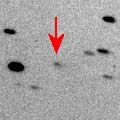
|
It becomes brightest about 4 months after the perihelion passage. It brightened up to 16.7 mag in mid September. It will reach to 15.5 mag and will be observable in good condition from November to January.
Date(TT) R.A. (2000) Decl. Delta r Elong. m1 Best Time(A, h)
Sept.23 5 30.38 15 6.0 1.494 1.897 96 16.7 4:23 (322, 66)
Sept.30 5 40.17 15 6.9 1.443 1.911 101 16.5 4:29 (335, 68)
|

|
It was observed at 17 mag in spring. It will be observable in good condition at 17 mag again in autumn. It will be fainter than 18 mag in December.
Date(TT) R.A. (2000) Decl. Delta r Elong. m1 Best Time(A, h)
Sept.23 5 48.11 18 10.7 1.731 2.039 92 16.8 4:23 (309, 66)
Sept.30 5 31.94 15 15.1 1.612 2.085 103 16.7 4:29 (340, 69)
|
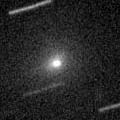
|
It brightened much more rapidly than expected after late April, and reached to 9.5 mag on June 15 (Willian Souza). Then it has been fading very rapidly. It is reported bright as 12.7 mag visually still now (Aug. 27, Juan Jose Gonzalez), however, it will be too faint to see visually soon. CCD observers reported that it has already fainter than 16 mag. Although it keeps higher than 20 deg in the evening sky until November, it may be too faint to observe soon even by CCD observers.
Date(TT) R.A. (2000) Decl. Delta r Elong. m1 Best Time(A, h)
Sept.23 16 54.58 -17 37.3 1.625 1.669 74 16.7 19:20 ( 41, 26)
Sept.30 17 15.28 -18 40.9 1.736 1.729 72 17.3 19:10 ( 40, 26)
|
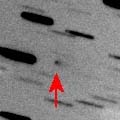
|
It was 18.3 mag in early September. fainter than originally expected by about 1 mag. It will brighten very rapidly in the morning sky after this. It will be observable in an excellent condition in November and December. But it may be 14.5 mag at best.
Date(TT) R.A. (2000) Decl. Delta r Elong. m1 Best Time(A, h)
Sept.23 6 9.10 3 55.4 1.419 1.702 87 17.2 4:23 (318, 51)
Sept.30 6 23.20 5 4.6 1.341 1.680 90 16.8 4:29 (324, 55)
|

|
Peculiar asteroid moving along an orbit like a comet. It is at opposition in October. It will reach to 16.5 mag and will be observable in excellent condition.
Date(TT) R.A. (2000) Decl. Delta r Elong. m1 Best Time(A, h)
Sept.23 1 16.12 0 33.5 1.483 2.452 160 17.1 1:11 ( 0, 56)
Sept.30 1 13.66 -0 41.7 1.433 2.420 167 16.8 0:41 ( 0, 54)
|
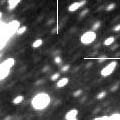
|
It keeps 17 mag for a long time after this until the end of 2007. It will be observable in good condition in 2006 autumn and 2007 autumn.
Date(TT) R.A. (2000) Decl. Delta r Elong. m1 Best Time(A, h)
Sept.23 19 25.05 44 38.0 3.397 3.783 105 16.9 19:20 (176, 80)
Sept.30 19 28.06 43 36.4 3.403 3.763 103 16.9 19:10 (159, 81)
|
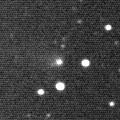
|
It was bright as 15 mag in 2004 and 2005. Now it is far away from the sun, but it is still observed at 17 mag in 2006.
Date(TT) R.A. (2000) Decl. Delta r Elong. m1 Best Time(A, h)
Sept.23 0 58.74 -15 42.9 3.128 4.079 158 17.1 0:53 ( 0, 39)
Sept.30 0 54.17 -16 7.2 3.141 4.095 159 17.1 0:21 ( 0, 39)
|
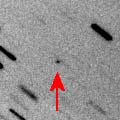
|
Although it was so faint as 20.7 mag on Aug. 2 (P. Birtwhistle), it brightened very rapidly up to 17.9 mag on Aug. 28 (Filip Fratev). The condition of this apparition is excellent. It will brighten furthermore rapidly after this, and it is expected to reach to 16.5 mag in October and November.
Date(TT) R.A. (2000) Decl. Delta r Elong. m1 Best Time(A, h)
Sept.23 4 18.12 18 34.5 0.803 1.517 113 17.5 4:12 ( 0, 73)
Sept.30 4 29.88 22 42.1 0.747 1.499 117 17.1 3:56 ( 0, 78)
|

|
It is outside of Jupiter's orbit. So it keeps 16.5-17.5 mag for a long time until 2008. In 2006, it keeps observable in good condition until November.
Date(TT) R.A. (2000) Decl. Delta r Elong. m1 Best Time(A, h)
Sept.23 20 46.88 -14 20.5 5.522 6.220 130 17.1 20:38 ( 0, 41)
Sept.30 20 42.44 -14 1.9 5.606 6.203 122 17.2 20:06 ( 0, 41)
|

|
It was observed at 17 mag in 2005 summer. It will reach to 17 mag again in 2006 summer. However, no observations have been reported yet in 2006.
Date(TT) R.A. (2000) Decl. Delta r Elong. m1 Best Time(A, h)
Sept.23 22 23.51 -14 20.6 2.451 3.372 152 17.2 22:14 ( 0, 41)
Sept.30 22 20.82 -14 42.8 2.514 3.383 144 17.3 21:44 ( 0, 40)
|

|
It reached up to 16 mag in 2005 summer in the Southern Hemisphere. It will keep 17.5 mag until January after this. Then it will be fainter than 18 mag in February.
Date(TT) R.A. (2000) Decl. Delta r Elong. m1 Best Time(A, h)
Sept.23 5 49.49 -22 24.4 4.496 4.645 92 17.3 4:23 (339, 30)
Sept.30 5 50.03 -22 41.1 4.452 4.679 96 17.3 4:29 (347, 31)
|
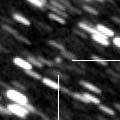
|
It will reach to 14.5 mag in 2007 summer, but it will be observable only in the Southern Hemisphere at that time. Now it is 17.2 mag (Aug. 27, J. Young). In the Northern Hemisphere, it keeps observable at 17.5 mag in good condition until autumn.
Date(TT) R.A. (2000) Decl. Delta r Elong. m1 Best Time(A, h)
Sept.23 19 27.55 0 33.6 4.617 5.080 112 17.4 19:20 ( 1, 55)
Sept.30 19 25.04 -0 45.5 4.679 5.035 105 17.4 19:10 ( 9, 54)
|

|
It reached to 6 mag in 2004. It had been visible visually until January. It has already faded down to 17.2 mag (Aug. 9, Ken-ichi Kadota). It will be fading slowly around 17-18 mag until December.
Date(TT) R.A. (2000) Decl. Delta r Elong. m1 Best Time(A, h)
Sept.23 2 56.85 -2 43.6 7.110 7.858 135 17.4 2:51 ( 0, 52)
Sept.30 2 53.30 -3 3.8 7.098 7.914 142 17.4 2:20 ( 0, 52)
|

|
New comet. It was discovered because it passed very close by Earth. Howver, because it is very small, it will fade out very rapidly.
Date(TT) R.A. (2000) Decl. Delta r Elong. m1 Best Time(A, h)
Sept.23 23 35.42 22 13.0 0.407 1.387 156 17.5 23:27 ( 0, 77)
Sept.30 23 45.13 19 7.7 0.420 1.405 160 17.6 23:09 ( 0, 74)
|

|
It was observed at 17 mag in late 2005. In 2006 autumn, it became observed again. It will be observable at 17.5 mag in good condition until November.
Date(TT) R.A. (2000) Decl. Delta r Elong. m1 Best Time(A, h)
Sept.23 2 27.21 24 14.3 4.626 5.400 136 17.5 2:22 ( 0, 79)
Sept.30 2 18.09 23 54.8 4.562 5.415 145 17.5 1:45 ( 0, 79)
|
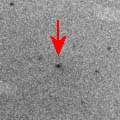
|
It will be fainter than 18 mag in October.
Date(TT) R.A. (2000) Decl. Delta r Elong. m1 Best Time(A, h)
Sept.23 23 28.46 -5 51.4 1.651 2.646 170 17.5 23:19 ( 0, 49)
Sept.30 23 23.70 -5 36.0 1.698 2.672 162 17.7 22:47 ( 0, 49)
|
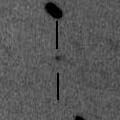
|
The perihelion passage is in 2008. It will be observable for several years after this at around 17 mag. But it may fade out rapidly just after the perihelion passage.
Date(TT) R.A. (2000) Decl. Delta r Elong. m1 Best Time(A, h)
Sept.23 4 54.13 11 8.8 4.501 4.873 105 17.6 4:23 (345, 66)
Sept.30 4 54.93 11 4.3 4.389 4.860 112 17.6 4:21 ( 0, 66)
|

|
It keeps 17 mag until January. Then it keeps observable util April when it becomes fainter than 18 mag.
Date(TT) R.A. (2000) Decl. Delta r Elong. m1 Best Time(A, h)
Sept.23 4 47.33 45 40.8 3.571 3.910 102 17.7 4:23 (196, 79)
Sept.30 4 50.04 46 37.2 3.475 3.901 107 17.6 4:16 (180, 78)
|
|
![]()
 C/2005 E2 ( McNaught )
C/2005 E2 ( McNaught ) C/2006 P1 ( McNaught )
C/2006 P1 ( McNaught ) P/2006 HR30 ( Siding Spring )
P/2006 HR30 ( Siding Spring ) C/2003 WT42 ( LINEAR )
C/2003 WT42 ( LINEAR ) 117P/Helin-Roman-Alu 1
117P/Helin-Roman-Alu 1 P/1991 V1 ( Shoemaker-Levy 6 )
P/1991 V1 ( Shoemaker-Levy 6 ) 73P-C/Schwassmann-Wachmann 3
73P-C/Schwassmann-Wachmann 3 (3200) Phaethon
(3200) Phaethon 52P/Harrington-Abell
52P/Harrington-Abell 114P/Wiseman-Skiff
114P/Wiseman-Skiff C/2005 L3 ( McNaught )
C/2005 L3 ( McNaught ) C/2004 B1 ( LINEAR )
C/2004 B1 ( LINEAR ) C/2005 B1 ( Christensen )
C/2005 B1 ( Christensen ) 84P/Giclas
84P/Giclas C/2006 CK10 ( Catalina )
C/2006 CK10 ( Catalina ) 41P/Tuttle-Giacobini-Kresak
41P/Tuttle-Giacobini-Kresak 76P/West-Kohoutek-Ikemura
76P/West-Kohoutek-Ikemura 2006 QL39
2006 QL39 C/2006 M1 ( LINEAR )
C/2006 M1 ( LINEAR ) P/2004 F3 ( NEAT )
P/2004 F3 ( NEAT ) 112P/Urata-Niijima
112P/Urata-Niijima C/2005 S4 ( McNaught )
C/2005 S4 ( McNaught ) P/2005 L1 ( McNaught )
P/2005 L1 ( McNaught ) C/2004 L2 ( LINEAR )
C/2004 L2 ( LINEAR ) C/2006 K4 ( NEAT )
C/2006 K4 ( NEAT ) C/2003 K4 ( LINEAR )
C/2003 K4 ( LINEAR ) P/2006 S1 ( Christensen )
P/2006 S1 ( Christensen ) C/2005 R4 ( LINEAR )
C/2005 R4 ( LINEAR ) P/2006 H1 ( McNaught )
P/2006 H1 ( McNaught ) 173P/2005 T1 ( Mueller 5 )
173P/2005 T1 ( Mueller 5 ) P/2005 SB216 ( LONEOS )
P/2005 SB216 ( LONEOS )![]()





























